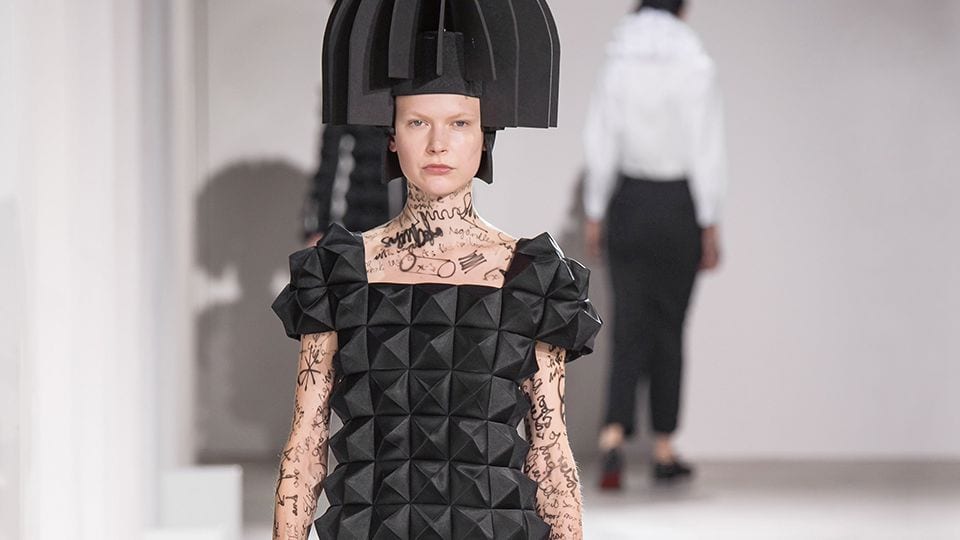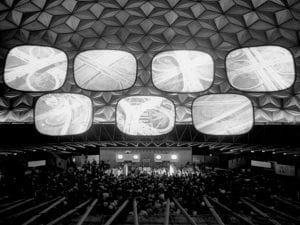The Metropolitan Museum of Art’s costume institute invites viewers to question the fashion world’s accepted opposition of hand versus machine.
“Since we announced Manus x Machina last year,” Andrew Bolton, Curator in Charge of The Costume Institute, says, “several people have asked if the title was inspired by Alex Garland’s film Ex Machina. It actually wasn’t, but it was influenced by an earlier science fiction movie – Fritz Lang’s Metropolis.” Of course, Ex Machina was itself at least partly references Metropolis and both films, each in their own way, explore the ambivalent relationship between man and machine, creator and creation. Both feature robotic protagonists disturbingly skilled at mimicking human behaviour and – either despite or because of this skill – are chillingly seductive to the point of destruction. Encapsulating the essence of our relationship with machines since the Industrial Revolution, they demonstrate our wonder and fear at their potential, laced with an implicit assumption that human and machine are fundamentally unequal and thus irreconcilable.
The driving principle behind Manus x Machina inhabits the midway point between the unashamedly negative portrayal of industrialisation of Metropolis and Ex Machina’s diametrically opposed and sympathetic portrayal of sentient machines. The exhibition seeks to reconcile the bifurcation of haute couture and prêt-à-porter, which Bolton describes as based on an “oppositional relationship” between the hand and the machine, that “has played out in fashion since the birth of haute couture in the mid-19th century” – a relationship predicated on the false understanding of “the hand and the machine as discordant instruments in the creative process.” It does so by presenting the two practices not as a dichotomy but as a continuum: in the place of predominance, it suggests an equal and mutually amplifying relationship that can be found in close collaboration.
Traditionally, Bolton suggests, haute couture has been aligned with qualities that are associated with the handmade, both positive and negative: “exclusivity, spontaneity, and individuality” but also “elitism, the cult of personality, and a detrimental nostalgia for past craftsmanship.” Ready-to-wear has been aligned with the concept of machine-led mass production and as a result carries connotations of “progress, democracy and mass production” as well as “inferiority, dehumanisation and one-dimensionality.”
Significantly, haute couture itself came to the fore with the invention of the sewing machine, perhaps, as Bolton sensitively points out, as a reaction to the levelling of the fashion playing field that the invention indicated. It is no wonder, then, that the tension-fraught relationship between haute couture and ready-to-wear has hinged on such differentiations, which serve to legitimise the notion that hand and machine are indeed agents in opposition.
Manus x Machina is made possible through a collaboration between the Costume Institute and Apple, a pairing in itself indicative of the very relationship between fashion and technology, which Manus seeks to unravel and examine. Of course, this isn’t the first occasion on which Apple ventures into the realm of fashion. The newest addition to the Apple family, the Apple Watch (launched in 2015) marks yet another innovation on the part of the company: wearable technology realised in the shape of a stylish luxury item.
The exhibition unfolds in the museum’s Robert Lehman Wing. It comprises a series of case studies, in the form of haute couture examples presented alongside prêt-à-porter counterparts, allowing visitors to evaluate the achievements of both craftsmanship and mechanisation, and consider them as a continuum. The show fans out in a series of rooms organised according to the traditional métiers of dressmaking as set out by Diderot in his Encyclopedia of the Sciences, Arts and Crafts, which Bolton asserts remain at the centre of recognised fashion. The traditional techniques of embroidery, featherwork, artificial owers, pleating, lacework, and leatherwork, stand alongside cutting-edge processes including 3D printing, computer modelling, bonding and laminating, laser cutting, and even ultrasonic welding.
Unsurprisingly, the list of designers featured reads like a Who’s Who of haute couture / the fashion industry of the 20th and 21st centuries: titans such as Coco Chanel, Mariano Fortuny, and Yves Saint Laurent rub shoulders with enfants terribles such as Jean Paul Gaultier, Alexander McQueen and John Galliano. Houses represented include Comme des Garçons, Givenchy, Christian Dior and Louis Vuitton. The exhibition showcases more than 150 items, chosen to reveal the manner in which, as Bolton notes, “the hand and the machine work in tandem in the creation of fashion.”
There are some awe-inspiring pieces on show, which exist under the opposing banners of design. Perhaps the ultimate show-stopping piece is the Karl Lagerfeld wedding dress that inspired Manus x Machina, which Bolton calls “a superlative example of the convergence of the handmade and the machine.” The train of the dress features a hand-sketched design, which subsequent digital manipulation imbued with “the appearance of a pixelated baroque pattern.” Further work involved hand-painting, transfer-printing done by machine, and hand-embroidering. Altogether, 450 hours of work by human and machine went into the final spectacular result, a gown that exudes elegance thanks to its simple lines and classical cut, whilst at the same time declaring itself a garment rmly situated into the 21st century, born out of artisan expertise and expert machine work.
A stand-out pairing of equally dramatic examples of traditional and innovative practices is presented in the Featherwork section. Yves Saint Laurent’s evening dress, worn by Pauline de Rothschild, reimagines and celebrates the beauty of the bird of paradise through the meticulous hand-glueing of every single feather to the fabric of the dress. The almost weightless quality of the final result is a testament to the painstaking process through which the form of the work was achieved. Contrasted with this example is a superb creation taken from Iris van Herpen’s Autumn / Winter 2013 collection. Consisting of laser-cut silicone feathers and machine-sewn cotton twill, the dress has been hand finished with real bird skulls and synthetic pearls. The silicone plumage imbues it with an almost sculptural quality, which more than holds its own as a triumphant statement on the use of techniques borne out of the age of technology.
Van Herpen’s impressive oeuvre stretches into the ensemble from the Spring / Summer 2010 collection, which adheres to a characteristic attention to detail; the garment is at once both futuristic in its attention to structure, and undeniably human in its uniqueness. Having been printed using selected laser sintering, each layer has been constructed separately: “If you look closely at the bodice, you can see the fine lines of print. In one millimetre, there are up to 10 lines. It’s almost as detailed as a fingerprint.” Continuing in this vein of pioneering design, Junya Watanabe’s fall ensemble 2015 is a reflection on geometric simplicity. Glossy pyramids protrude from the outfit, adorning its prospective model in material that is both striking and ready for the age of technology.
The Embroidery section includes an intriguing pairing of a 1952 Christian Dior dress and a 2011 Hussein Chalayan piece. The Dior gown features a generous spray of hand-embroidered flowers, carefully arrayed to create an effect that Bolton describes as “a meadow’s variegation.” This is achieved by ensuring the owers are densely applied around the waist, gradually becoming sparser towards the edges. The final result is charmingly reminiscent of the colours and textures of spring, achieved through the rich yet unoppressive embroidery. Set against this work is Chalayan’s Floating Dress, an extraordinary creation of spray-painted cast fiberglass. It has a warm, metallic golden hue, and features handmade paper and crystal flowers. Bolton explains: “The white flowers are intended to represent pollen. They’re hooked onto the dress via individual spring-loaded hinges that are controlled remotely. When the hinges are released, the pollen swarms around the dress like the seed- bearing parachutes of a dandelion flower in a gust of wind.”
Each example is only made possible by the speciflc attributes of its production: no machine could demonstrate the critical understanding of space necessary to achieve the cascading effect of the Dior dress; no amount of handiwork could replicate the mechanised hinges necessary to produce the pollen cloud of the Chalayan dress. Both creations stand next to each other as subsequent chapters of the same story, inextricably connected, both carrying the same weight and significance. It is impossible to conceive of the one without the other: the vision behind the Chalayan design is partly made possible because the Dior dress has existed, yet the latter, in turn, gains its importance and stature partly thanks to the fact it inspires creations such as the former.
The equal relationship of hand and machine, and its consequent ampli cation of what either side can achieve with the help of the other is, perhaps, epitomised in the “x” of the show’s title. There is, of course, the obvious allusion to the “deus ex machina” theatrical device, whereby a mechanical contraption allowed a deity to swoop into the action and save the day when there appeared to be no resolution. There is certainly an element of happy, if not slightly unbelievable, resolution of conflict, an opportunity to metaphorically bury the hatchet between handmade and machine-made.
Here is no dependency though: manus isn’t “ex” machina, it doesn’t rely on it, with all the submission this implies. It doesn’t yield to either. The show goes to great lengths to question the values, both negative and positive, traditionally ascribed to either side of the fashion argument. More than anything, Manus x Machina seeks to reject this binary approach instead bringing to the fore the continuation of the two practices. The “x” in Manus x Machina begs to be read as the multiplication symbol, triumphantly leading us to ascertain that hand and machine are not at odds with each other but rather multiply each other, widening the horizon.
The museum will also be publishing an accompanying book, distributed by Yale University Press. Written by Andrew Bolton, it has 256 pages, 250 colour illustrations and interviews with some of the many contributors, who include Hussein Chalayan, Iris van Herpen and Miuccia Prada.
Words Regina Papachlimitzou
Manus x Machina: Fashion in an Age of Technology. The Metropolitan Museum of Art’s Costume Institute, New York. Until 14 August.





